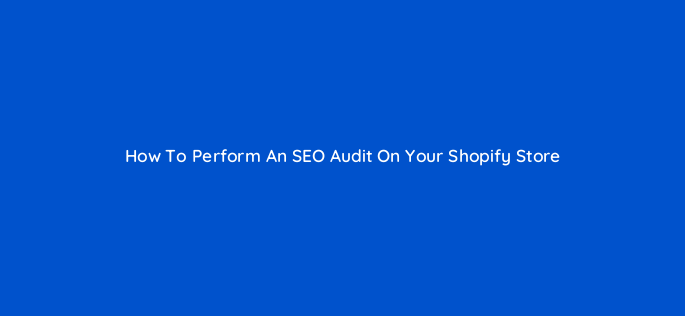Advertisement
The world today’s highly digital. That’s why running an ecommerce store without a solid SEO strategy is like a fish trying to swim upstream. It’s a tiresome task that’ll most likely result in zero progress.

Shopify is worth its weight in gold when talking ecommerce. Yet, just like every outpost on the digital map, your Shopify store demands fine-tuning to make it a beacon for search engines. That’s where the all-important SEO audit comes to the fore.
An SEO audit is basically you getting into your website’s underbelly. What are you looking for exactly? Your website’s general existence to find out where it stands in search results, its overall health, and most definitely performance. Sounds technical, doesn’t it. Well, yes, it is. But that’s why we’ve stepped in.
Walk with us. We’ll take you step-by-step till you know how to conduct an SEO audit on your Shopify store.
Step 1:Crawl Your Site
Screaming Frog, Ahrefs, or SEMRush. Now, this sounds like something out of a Quentin Tarantino movie. But no. These are just examples of spiders whose sole job is to crawl your website.
These tools systematically walk all over your website and mark down important SEO elements. They spot things like broken links, duplicate content, missing meta tags, and those pesky pages that take too long to load.
Resolving these issues go a long way in improving your website’s visibility. Oh, and how happy the search engines are when you do that? They may even bump you up the top of search engine result pages (SERPs).
Imagine what this top spot can do to your store? Now, stop imagining. Reach out to your choice of Shopify SEO pros and let them take you to the top.
Step 2: Analyze Your Website Structure
If your web structure is solid, search engines find your content pretty easy to index. Meaning? Google understands what your website is all about and decides where best to store the content for easy retrieval. Here are some of the key aspects to consider when analyzing your website structure:
- URL structure – The URLs of your pages should be descriptive and contain relevant keywords. For example, instead of ‘www.yourstore.com/product123’, use ‘www.yourstore.com/women-leather-boots’.
- Navigation – Can visitors easily find what they’re looking for? Aim for a user-friendly navigation structure.
- Internal linking – Link related pages within your site to help search engines understand your content context and user flow.
Nailing this process can allow search engines to better understand, index, and rank your site.
Step 3: Conduct An On-Page SEO Review
On-page SEO involves optimizing your site’s content and technical aspects to make it easily discoverable by search engines. This enhances your visibility when users search for your offerings. So, what should you adjust to attract customers to your Shopify store?
- Title tags – Love vintage Rolex watches? Use that passion as your page headline. It helps search engines link your page to customers seeking your products. Try this title tag: ‘Vintage Rolex Watches – Your Store Name’.
- Meta descriptions – Search engines love when this description is clear as day to let customers know what exactly you’re stocking in your Shopify store. A perfect example? ‘Explore our wide collection of vintage Rolex watches. Dive into history with our meticulously maintained and restored timepieces.’
- Keyword usage – Stand out from others selling vintage Rolexes on Shopify with keywords. Highlight your specialty with phrases like “vintage Rolex” and “restored Rolex watches” in your content.
- Image optimization – Since web crawlers can’t see images, use relevant alt tags for sense-making. For a vintage Rolex picture, tag it as “vintage Rolex watch 1950s”. Keep image files small for faster page load times.
- Mobile-friendliness – Shopify’s in-house stats say that 66% of orders in merchant shops come from mobile traffic. So, how do you get a chunk of these guys? Make sure your store gives mobile users the time of their lives. Use Google’s Mobile-Friendly Test tool to analyze your website.
- Page speed analysis – How fast your page is can affect how high your store ends up on SERPs. Use tools Google’s PageSpeed Insights or GTmetrix to analyze and improve your page load speed.
Nail this, and your website can significantly rise in SERP rankings.
Step 5: Conduct An Off-Page SEO Review
Whereas on-page SEO was in your hands, off-page plays by a different set of rules. Here, it’s others who determine how your page ranks on the SERP.
So, focus on getting some really good backlinks from legit sources. You can use tools like Ahrefs or Moz to check out your backlink profile and see where you need to improve.
Also, if you can get people to share your stuff on social media, that can help your search engine ranking too. So, make sure to encourage social sharing of your content. By doing these things, you can make your Shopify store more popular and hopefully make more money too.

Wrapping It Up
If you’re trying to get more people to find your Shopify store, you should think about doing a full audit of your site’s SEO. This way, you’ll definitely know what’s working and what needs more love to send your store to the top of the SERPs.
It might seem like a pain, but it’s totally worth it because you’ll get more visibility, traffic, and sales. Plus, if you need some help, there are experts out there who can give you a hand. Reach out today and begin your journey to the top.
Subscribe to our mailing list and get interesting stuff and updates to your email inbox.
